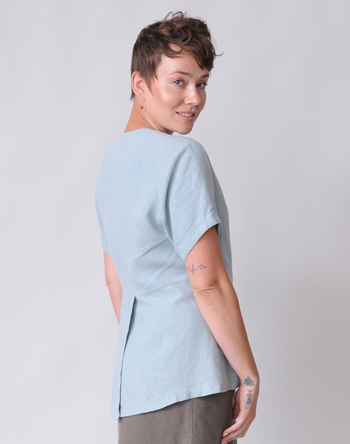Shopping for womens eco-fashions? Here’s the fact & fiction.
Terms like “sustainable clothing” and “eco-fashion” get tossed around a lot these day to describe some womens wear. Like the word “natural,” sustainable has been misapplied and misunderstood. Read on to find out what genuine sustainability in women’s wear looks like today and how Sympatico plays a part in that.
What does “sustainable” mean when it comes to women's clothes?
Sustainable, or eco fashion, is a design philosophy that’s still evolving. Its aim is to create a system that can be supported indefinitely from the standpoint of environmental and human well-being. Each step in creating sustainable clothes, from growing the raw materials to manufacturing to distributing them, must be environmentally friendly and protect the health of humans and environmental systems.
With the average American discarding about 70 pounds of clothing every year, the fashion industry is the second leading cause of worldwide pollution. Sustainable clothing is an antidote to the global economy’s fixation on fast fashion.
A handful of clothing makers are now taking back consumers’ worn clothing for recycling of both garments and their fibers to create new products. This is the cutting edge, where inputs and outputs are pretty much equal and the idea of indefinitely sustainable gets really real.
At Sympatico, I use a hemp/Tencel fabric made in a closed-loop system that keeps the land and water clean. Both fibers are grown without pesticides or artificial fertilizers. And by handcrafting the Sympatico line in the USA, I’m able to ensure that human wellbeing is factored in too.
Learn more about Sympatico’s sustainable hemp/Tencel fabric.
Acacia’s Princess Top and Angled Skirt are made sustainably using Earth-friendly fibers and people-friendly practices.
Not all “natural” womens clothing is sustainable clothing
For example, conventionally grown cotton is natural but it’s not considered sustainable since it is drenched in pesticides and herbicides. According to the Organic Trade Association, conventionally grown cotton uses 25% of the world's insecticides and more than 10% of the pesticides. They estimate that in the US, 1/3 pound of agricultural chemicals is typically used to make a single tee shirt.
Though natural dyes may be obtained from vegetable or animal sources without chemical processing, they have their downsides too. Most importantly, natural dyes are not currently practical except in small quantities.
Dig deeper: Why I Use Low-Impact Dyes
Anastacia’s Swallowtail Top is handcrafted in the USA from a sustainable blend of hemp and Tencel.
Organic clothes produced abroad are not the most sustainable clothing.
Because it travels thousands of miles before reaching its market, organic clothing produced abroad has a larger ecological footprint than organic clothing produced in the USA.
Though our fabric is imported (very little fabric is currently made here), designing, grading, sampling, cutting and sewing is done in the USA resulting in a smaller carbon footprint and a more sustainable product.
To be considered sustainable, clothing should be:
- Safe for humans and the environment in all stages of its life cycle.
- Use energy, materials and processes that come from renewable or recycled sources, such as biomass or wind energy or organic cotton, hemp, wool, linen or Tencel.
- Safely returnable to either natural or industrial systems.
- Made to last and able to be reused or recycled.
- Produced by workers who receive fair wages and enjoy healthy working conditions.
It's tough for consumers to know what happens in every step of the production process, so there is a cultural component in making sustainable clothing the norm. Better designs and more availability together with increasingly informed consumers who demand sustainable clothing have the potential to transform the clothing industry.
Steps you can take to make your wardrobe sustainable
While awareness and transparency about sustainable clothing grow, consumers can exert their influence by
- becoming informed about sustainability issues
- buying clothing made of durable fabrics in timeless styles
- repairing, recycling and re-using clothing
- buying second-hand clothing
- choosing products made with genuine environmental concern
- washing clothes less often, at lower temperatures, using eco-friendly detergents
- avoiding purchases of garments requiring dry cleaning; when that's not an option, using "wet cleaning" instead of conventional dry cleaning.






